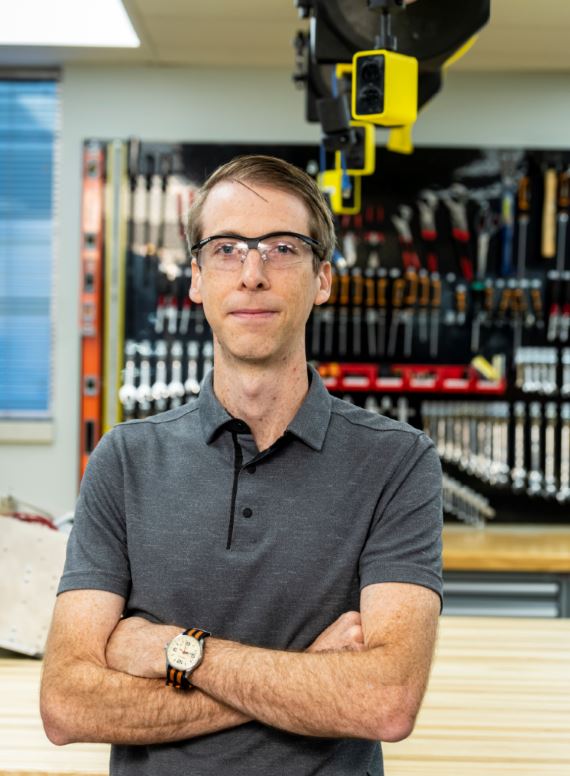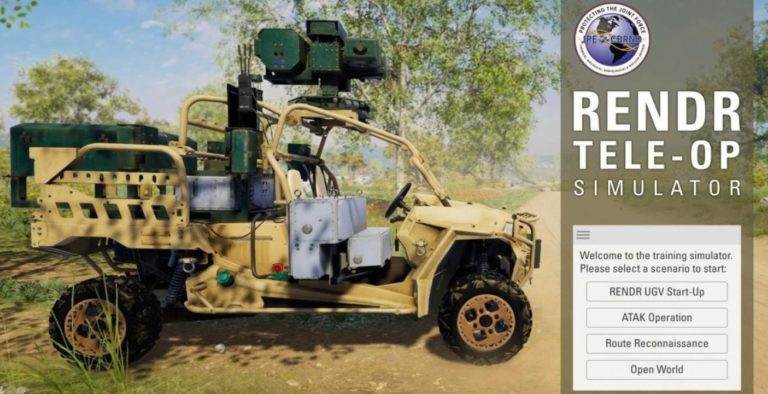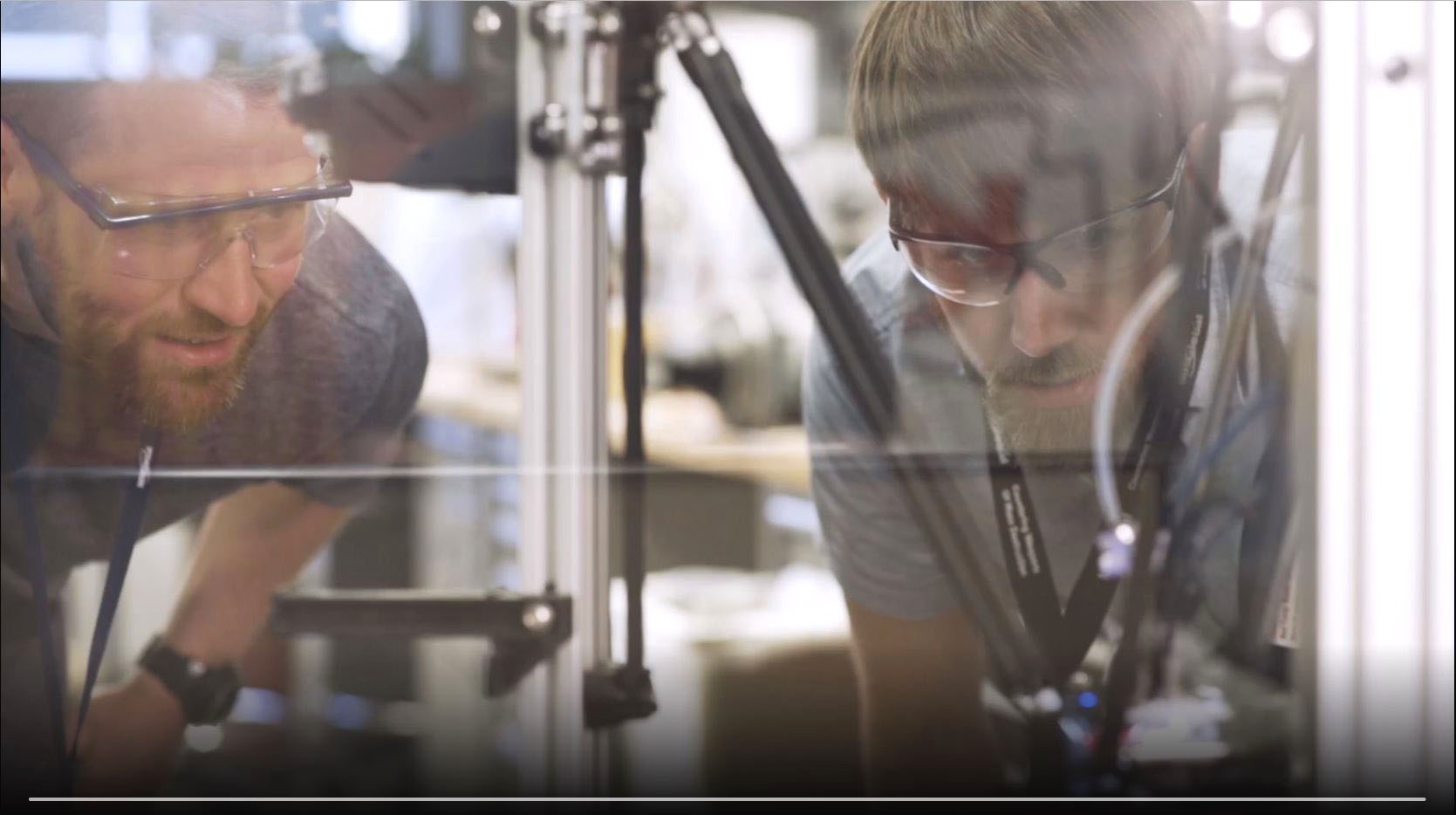MRIGlobal Expertise Includes Software, Electrical, Mechanical, Chemical and Field Engineering
At MRIGlobal, engineering is everywhere.
From one of our largest engineering projects with the Athena Mobile Laboratory to one of our smallest, the microfluidic device designed by Arjun Garapaty last summer during his internship, and online projects like the Open Architecture Data Management System (OADMS) described in our 2022 Impact report.
In doing so, we support manufacturing integration capabilities including mobile laboratory design and construction, related systems fabrication, testing of fieldable military equipment, medical device development and testing, engineering and technical management support, technical analysis, and related training. In the engineering laboratories at our Kansas City headquarters, we also rapidly design, test, evaluate, and manufacture high quality prototypes with the goal of improving national defense and public health.
How Do We Engineer?
At MRIGlobal, we approach engineering through what is called systems engineering (SE), an interdisciplinary engineering field involving processes and procedures needed to translate business and enterprise needs into systems and products. SE focuses on integrating specialized technical disciplines to create complex systems as well as optimization of those systems and products over their life cycle. SE is used across a range of fields, including defense, software, transportation, technology development, and infrastructure. Its use helps ensure we not only build the system right, but that we build the right systems to meet the needs of our customers.
Typically, systems go through four stages during their life cycle: pre-acquisition, acquisition, utilization, and disposal. SE is primarily involved during acquisition, structuring the technical development of a system. Acquisition can be broken down into various design and development sub-phases that take a system from concept to construction or production. During this process, system needs and high-level requirements are systematically analyzed, refined, documented, and reviewed. Design review meetings are held to ensure that sufficient detail is captured and technical risks are addressed before the project proceeds to the subsequent phases.
Although the research and development phases are typically considered a pre-acquisition effort, significant development may be required during the conceptual and preliminary design phases as well. These phases may involve developing custom components or custom sub-systems and/or evaluating custom against commercial-off-the-shelf (COTS) and modified COTS options. These evaluations may require iterative prototyping, supported by development tests and evaluation.

By incorporating systems thinking, MRIGlobal’s engineers can better understand the big picture, identify potential bottlenecks, and optimize the overall system performance. This holistic systems-based approach also encourages collaboration, drives continuous improvement, and ensures that solutions are innovative, robust, efficient, and meet client expectations. Ultimately, a systems engineering framework that embraces systems thinking is the key to the successful development, implementation, and maintenance of complex systems in an ever-changing world.
Requirements of Systems Engineering
Requirements development and requirements management encompasses a major part of SE. Well-written and well-documented requirements are critical for developers, engineers, and specialized disciplines in developing a system. They aid in managing project scope and form the basis for system verification.
During initial stages of requirements development, business and stakeholder needs are requirements that are translated into system requirements. System requirements are then decomposed into sub-system and component level requirements. Indirect, derived, requirements are identified and formulated so that the final system meets specific performance requirements. Traceability within a Requirements Breakdown Structure (RBS) is critical in ensuring business and stakeholder needs are met. A fully linked RBS aids in managing scope creep by identifying untraceable requirements.
The SE approach to requirements ensures that they are all necessary, unambiguous, feasible, verifiable, and appropriate to their level. Linking requirements to verification metrics and rational statements ensures that the final system can be adequately tested and that critical design intent is not overlooked in detail design and appropriately considered if future design changes are made.
The SE process aims to develop systems that are verified against the requirements documentation produced during the acquisition phase, and validated against the customer and stakeholder needs and requirements. The verification process is enabled by verification requirements that are captured and linked to system, subsystem, and component requirements within the system’s RBS. Testing and evaluation planning is started early in the development processes and conducted at various levels to produce an overall technical risk mitigation effort. Consideration must be given to the appropriate verification method: testing, demonstration, inspection, or analysis.
What Are the Benefits of Systems Engineering?
With a complete understanding of system deployment, operation, maintenance, and retirement/disposal, we are positioned to produce systems with low life-cycle cost that also meet business and stakeholder needs. When a system is in service, it then requires training, physical inputs, service and repair components, and maintenance. Expansion or addition of support systems (such as hiring personnel, training, parts tracking, shipping/receiving, material storage, etc.) may be needed.
Planning for the end of the products’ life can reduce the overall cost of ownership, such as through sale or disposal of the system or system elements. For example, if the system was constructed using hazardous components, then disposal costs may increase. Deployment and retirement concepts are developed early in the acquisition phase to ensure they are accounted for in conceptual and detailed design, while also being understood by the customer. It is through this process that technical trade-offs are identified and cost-benefit analyses are conducted.
Our Expertise in Software and Electrical Engineering
MRIGlobal’s Software and Electrical Engineering team combines electrical design and software development resources into a cohesive element that can efficiently design, produce, integrate, and program all manners of electronic devices. We have extensive experience in hardware development, PCB design, device optimization, and integration of CBRNE sensors.
Our software engineers provide custom solutions ranging from database and web applications to specialized Graphical User Interfaces (GUIs) and cutting-edge Augmented Reality environments. Whether ground-up prototype design, full system integration, or virtual training environments, we support any and all hardware or software needs.
We also have experience developing applications ranging from firmware on various architectures to fully integrated web applications using a wide array of operating systems, languages, databases, and frameworks. Code is developed using Agile methodology, which allows clients to provide continual feedback throughout the design process.
Our electrical engineering laboratory is focused on electronic design, mechanical prototyping, electrical design, sensor development, aerosol engineering, and testing and evaluation of large bench-top and small field-portable devices. This includes the necessary software and hardware to design, populate, test, and rework custom circuit boards in-house.
Software Engineering to Keep Warfighters Safe
Threats to the Joint Forces from chemical and biological weapons remain significant. To help keep warfighters safe, candidate warning systems must be proven prior to fielding.
To simplify that effort, we designed and built the Open Architecture Data Management System (OADMS). This user-friendly, secure, and expandable data management system enables the efficient operation of the Test Grid at Dugway Proving Ground, which is a key facility for proving the efficacy of new and upgraded chemical and biological detectors.
The OADMS enables remote control and real-time situational awareness of all Test Grid fielded assets like point and standoff detectors, meteorological sensors, and simulated threat cloud production systems. The system automatically collects and synchronizes data from these numerous disparate devices and presents it to the analysis team in a standardized format, enabling rapid evaluation of candidate detection systems.
With this system in place, the Test Grid provides unmatched capabilities for conducting chemical and biological simulant testing. This streamlines development of effective threat detection sensors and protection equipment that keep warfighters safe in the field.
Graphical User Interface Development
Data integration is nothing without visualization, so we provide custom graphical user interface (GUI) and Common Operating Picture (COP) solutions ranging from advanced plugins for existing visualization tools to custom, platform-independent Rich Internet Applications.
Device Integration
Our Software and Electrical Engineering teams can also integrate devices into centralized data management systems. If a device can be connected to a computer or a network, we can provide access to its capabilities through a custom interface.
Augmented and Virtual Reality
No device? No problem. Augmented reality and virtual reality capabilities allow our experts to take a 200 page instruction manual, extract the vital information, and create a training module that can be loaded onto an AR/VR device, using the Unity game engine and the Microsoft’s HoloLens 2. The simulation of hands-on training is valuable in countless applications, from lab work to training on advanced equipment, enabling a user to interact with a project model. Eliminate the need for on-location training and experience the freedom offered by AR/VR devices loaded with custom developed training modules. Convenient training at your fingertips without the need for travel or schedule coordination.
Recently, we collaborated with ForgeFX to develop Checkpoint, an augmented reality tabletop mission planning prototype application built for the Microsoft HoloLens 2. This application was developed specifically to accommodate the type of missions that utilize the Nuclear Biological Chemical Reconnaissance Vehicle (NBCRV), a high-speed armored carrier equipped with a Sensor Suite Unit that detects multiple hazardous contaminants.

Through a separate collaboration with ForgeFX, we created a robust, cutting-edge virtual simulator for training on the remote operation of an unmanned ground vehicle (UGV). This effort supports the Joint Program Executive Office for Chemical, Biological, Radiological and Nuclear Defense (JPEO-CBRND) NBCRV Senor Suite Upgrade program, where MRIGlobal’s software engineers integrate a suite of CBRN sensors onto reconnaissance and unmanned vehicles.
Whether software, electrical, mechanical, chemical, field engineering, or working in collaboration with our research chemists and biologists, engineering is everywhere.
GETTING STARTED WITH MRIGLOBAL
Contact MRIGlobal to further understand the critical role of our engineers in programs across the institute. If you are part of an agency, business, or academic institution seeking assistance with a project, use our Project Quote Tool to get started.
SIGN UP FOR OUR NEWSLETTER
Sign up for the MRIGlobal newsletter! It’s the best way to get the latest updates in the world of applied scientific engineering research delivered directly to your inbox.

